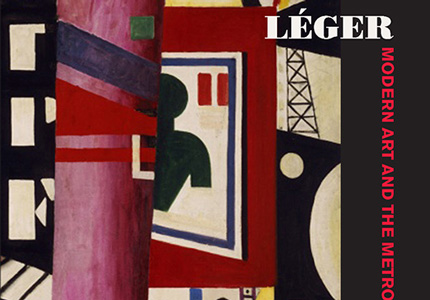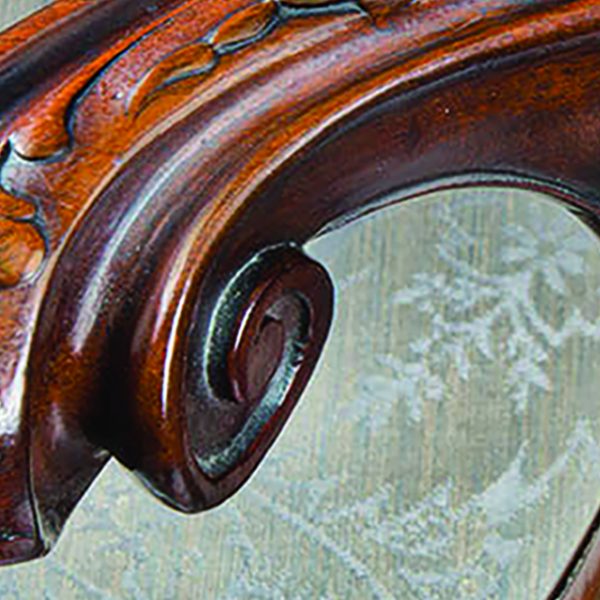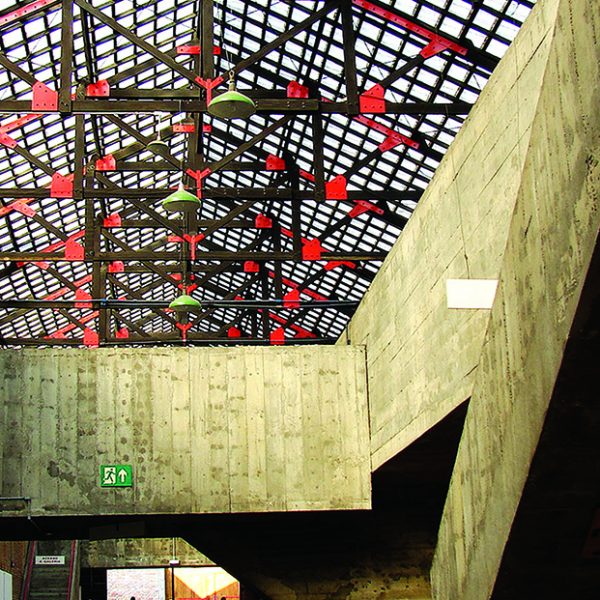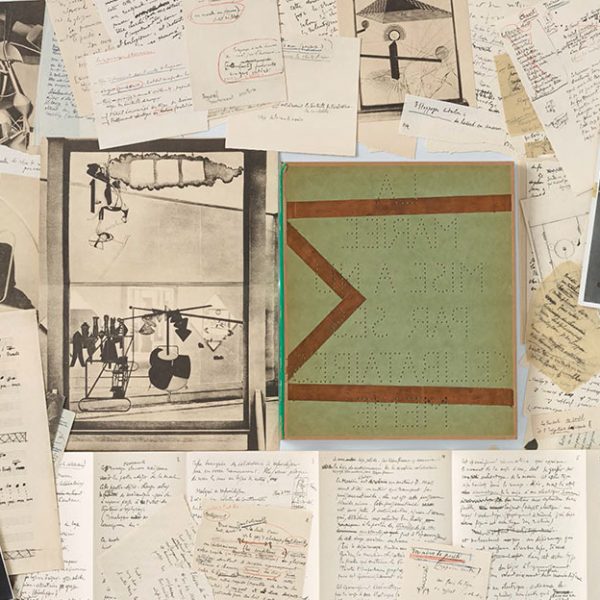On the Space of an Exhibition: From Curator Anna Vallye

Edited by Anna Vallye; With contributions by Christian Derouet, Maria Gough, Stuart Liebman, Spyros Papapetros, Anna Vallye, and Jennifer Wild
Anna Vallye—
The exciting thing about any art exhibition is certainly the opportunity it provides to see a number of remarkable works in the same location at the same time—its event quality. But it is also in what might be called an exhibition’s phenomenal quality—a capacity to elicit aesthetic, historical, and conceptual relationships among works staged in space, thus making those relationships available to reflection through embodied experience. The exhibition convention is made rich and challenging through these effects of spatial unfolding, which compress years and geographies into square feet and encode aesthetic experience with frameworks of meaning.
The Philadelphia Museum of Art show “Léger: Modern Art and the Metropolis” demanded from the start that significant attention be devoted to the choreographing of spatial relationships. The painting at its center, Fernand Léger’s monumental post-cubist canvas The City (1919) in the PMA collection, springs from a revolution in the representation of space at the beginning of the twentieth century. In breaking the laws of single-point perspective, modern painting challenged the “symbolic form,” as art historian Erwin Panofsky defined it, structuring all knowledge of the world in the West since the Renaissance. Cubism’s affront to humanist epistemology was so evident that the poet and critic Guillaume Apollinaire called cubist painting, in 1913, “inhuman”. This was great praise. Space in The City is not constructed as an intersection of Cartesian axes that converge in the eye of the beholder, but rather as a decentering accumulation of disparate signs networked through localized formal confrontations, contradictions, or tensions. The City above all, but likewise all of Léger’s best paintings, foreground the organization of pictorial space in a very sophisticated way. The artist’s painterly spaces, as Spyros Papapetros argues in the exhibition catalogue, create a structural analogy for the operations of thought, or a “conceptual architecture.”
Léger is an artist who thought hard about space in his paintings. In the 1920s—the decade addressed in the PMA exhibition—Léger was also especially preoccupied with the relationship between painting and its surrounding environment. This was, in fact, an overarching concern for many of the artists and designers featured in the show. If the traditional framework of pictorial space could be challenged, so could the conventional boundaries between works of art and other spaces and experiences. In pursuing diverse artistic practices—sometimes several at once—Léger and his avant-garde colleagues upended divisions segregating the conditions of reception for each art. They proposed that a musical composition could be watched, a poem could be looked at, a film could be framed on the wall like a painting, and a painting could be designed so as to be rushed by hurriedly like an advertising poster on a busy street. Hierarchies of spaces and experiences isolating the different arts—as well as art and everyday life—were being torn up and reconfigured in networks of new alliances and contradictions.
All of this presented a very interesting challenge for exhibition design and installation. It was a question of how to activate the physical space of the exhibition so that it mobilizes this lively discursive traffic across artworks, in which each could be seen to approach the boundary of its expected conditions of reception and stage there a mutually creative or disruptive encounter with its fellows. First, there had to be a plan, a spatial diagram—what architects call a parti. So the Museum invited Christoff: Finio Architecture, a New York-based firm, to help devise a basic conceptual scheme for the show. This firm was chosen in part because it is rooted, through the training and work experience of the partners, in the approach to design first formulated by modern architects in the 1920s. We asked Christoff: Finio to direct at the Museum a one-day seminar or think-tank, with the participation of graduate students and faculty in exhibition design, architecture, and urban studies from Philadelphia-area academic institutions.[1] The architects presented for discussion several conceptual schemes. We wanted to use those proposals as a springboard for broader discussion about the relationship between urban space and the space of the gallery, and about the role of exhibition architecture in framing viewing experiences and curatorial decisions.
After this day of reflection, Christoff: Finio worked in collaboration with Jack Schlechter, the Museum’s Director of Installation Design, and me to work out the final exhibition architecture. The fundamental idea that emerged from our conversations was that of a protean space that unfolds experientially through movement by sequentially bringing multiple discrete and distant nodes into visual relationship. This was analogous to the effects of perceptual compression, layering, or density characteristic of the urban fabric as experienced at street-level. I was also reminded of the effects of “interpenetration” in modern architecture described by the architectural critic Sigfried Giedion in the 1920s—the perceived intermingling of disparate spaces realized through motion, in which the boundaries between inside and outside, building and city, are blurred. This kind of a porous space, with distant corners brought into changeable alignment without being necessarily physically traversable, would enable me to activate the network of “floating relations” (Giedion’s words) among artworks on the checklist, encounters that were both aesthetic and conceptual.
Giedion saw prototypes of these “interpenetrating” spaces in the glass and iron structures of the late nineteenth century in Paris, such as bridges, arcades, and railway stations—and above all, the Eiffel Tower. The main longitudinal axis of the exhibition became something of an homage to this vision. The show opens with a projection of the film taken by Thomas Edison in 1900 as he ascended up the elevator in the center of the Eiffel Tower, looking through its iron girders at the city beyond. As you walk around a floating screen that hosts this projection, you glimpse The City in parallel, off in the distance. The space of the painting—which is often thought to be cinematic—and the space of the film echo one another. Bypassing The City, you see off in the distance a theatrical backdrop designed by Léger in 1922. It is a novel permutation of the compositional ideas of the painting. You see The City’s ambitions to a different scale and mode of reception, its spectacular theatricality; but you also see how the painting resists the decorative function of a backdrop.
In the main body of the show, the walls are treated as layered planes that slide past one another, so that any sense of enclosure is tentative and temporary. This allows for correspondences to be drawn across the different thematic areas of the exhibition, which are frequently visually permeable without being physically traversable. For example, a window-like opening placed between the areas of Publicity and Space enables a visual connection between two major paintings by Léger: Composition with Hat and Hands (1927) and The Large Tugboat (1923) across from each other. Each can be seen by turn in two contexts, foregrounding different aspects of the works. The monumental quality of the former is elicited when it is seen through the window, especially juxtaposed now with Theo van Doesburg’s mural-like Counter-Composition V (1924); while The Large Tugboat evokes the graphic language of print and advertising. Likewise, the poster by Jean Carlu for the Disques Odeon recording company falls within the line of sight of Marcel Duchamp’s Anemic Cinema (1926), a film of disks rotating like phonograph records, in an adjacent space. It is a reminder that the challenge to the practice of painting represented by the advent of audio and visual recording technologies was sister to that mounted by the mass-produced images of advertising.
While any exhibition relies, to some degree, on the implicit analogy between physical and discursive space, “Léger: Modern Art and the Metropolis” really thrives on this confluence. The exhibition space enables the network of relationships across the diverse objects and projects on view to be eminently fluid, multivalent, and dialogical. Like the group of works gathered here, the show is a product of multiple and garrulous authorship. It puts the tentativeness of curatorial organization on display, in turn inviting unprogrammed encounters and discursive reconfigurations from its visitors.
[1] The exhibition design seminar was spearheaded for Christoff:Finio by Thomas Ryan. It included the participation of the following students and faculty from Bryn Mawr College, Temple University, the University of the Arts, and the University of Pennsylvania School of Design: Margo Angelopoulos, Daniel Barber, Louise Barrett, Ashley Geremia, Kristin Ionata, Elizabeth Malish-Olson, Anna Moblard Meier, Cathy Moore, Jessica Morris, Gosia Primavera, Patricia Roth, Yuhuizi Wang, Anna Weichsel, Caroline Wineburg
Anna Vallye is an Andrew W. Mellon Postdoctoral Curatorial Fellow at the Philadelphia Museum of Art and editor of the catalogue accompanying the “Léger: Modern Art and the Metropolis” exhibition at the Philadelphia Museum of Art.


























